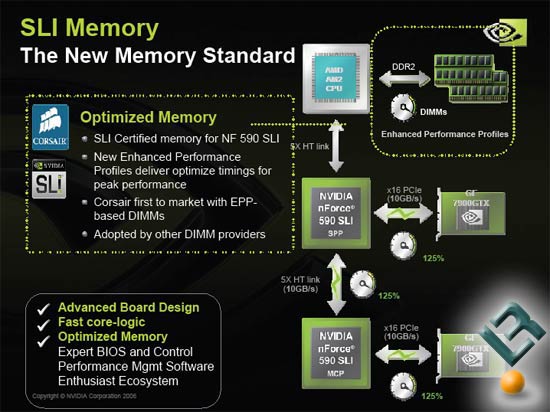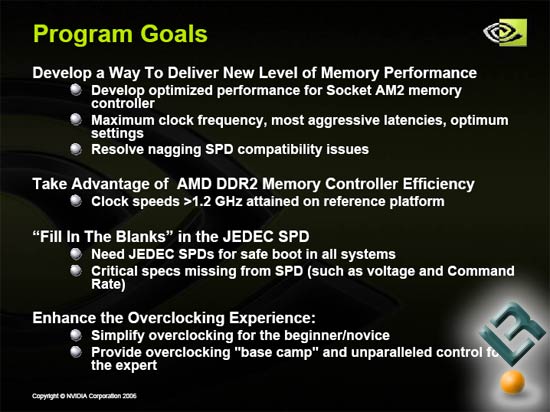DDR2 Memory: Enhanced Performance Profiles (EPP)
What Enhanced Performance Profiles Mean To You
NVIDIA just minutes ago announced the results of a collaborative memory development effort called Enhanced Performance Profiles, or EPP. EPP is going to change the way many computer users will use memory as it will allow for advanced performance memory settings to be built into high performance memory DIMMs for higher levels of overall PC system performance.
All DDR2 Unbuffered DIMM modules are required to include a Serial Presence Detect (SPD) EEPROM to allow them to be properly recognized by target systems. The contents of the SPD are defined by the JEDEC council. While the JEDEC SPD definitions have been used very effectively, they are not sufficiently comprehensive for overclocking applications. In such applications there are many parameters that are modified, and no provision exists in the JEDEC SPD specification to allow the system to make these changes automatically. NVIDIA has been able to take advantage of the unused area in the SPD and instersted usable data that will improve performance and increase the ease of use for many users.
If you are an enthusiast and currently set your own advanced memory timings Enhanced Performance Profiles wont be much help to you and many might find this as a “hand holding” attempt to bring more into the enthusiast community. I am not a fan of “Auto” anything, so at first I didn’t like the sound of EPP, but after being briefed by NVIDIA and Corsair I do believe that EPP will be a thing that helps everyone in the long run. Consumers who don’t know about Address Drive Strength or the Minimum Cycle time at Supported CAS Latency will find that Enhanced Performance Profiles will automatically setup their system for fast, yet stable performance right out of the box.
Before we start to lose you let’s take a look at the NVIDIA presentation on this new open memory standard.


On this slide it is important to note that NVIDIA is calling memory that is support on their upcoming nForce 500 series “SLI Memory”. SLI Certified Memory for the NF 590 SLI will have the new EPP settings and Corsair was the first to market with these EPP-based DIMMs. Corsair was one of the companies that really took off and ran with Enhanced Performance Profiles as their customer base is largely enthusiast. Other memory companies like Kingston and OCZ have been working with NVIDIA on EPP modules and when the upcoming AMD AM2 processors come out will be ready to support EPP.

Here we see just why NVIDIA wanted to impliment EPP on their chipsets. They wanted to deliver a new level of memory performance and reduce the number of compatibility issues that many of us encounter on enthusiast motherboards. NVIDIA was also very open in letting us know that they are easily getting DDR2 memory frequencies over 1.2GHz on their reference platforms! NVIDIA firmly believes that by placing EPP settings in the SPD that they will enhance the overclocking experience for all users and give the memory experts the information of unparalled control of memory timings.

Comments are closed.